ABSTRACT
This paper deals with some aspects of the relationship between man and water demonstrated via the example of large hydraulic structures constructed in the Czech lands. Based on this relationship, principles of the practical functioning of ideas and ideologies, including religion, can be presented. It is not just about “pagan” cults, aiming directly at worshipping water as a living being. Christianity also significantly influenced the framework in which water management operated across the centuries and, at the same time, new ideas associated with the Enlightenment and the Industrial Revolution during the 18th and 19th centuries. A key part of the paper is focused on the topic of the construction of large hydraulic structures in the 20th century, which was particularly intensive in its second half. It also mentions political, ideological, and natural changes which were, at the beginning of the 21st century, reflected in man’s relationship with water resources and the possibilities of influencing them.
Motto: “…Wayside shrines in the countryside, plant motifs of cathedral builders, Baroque unity between nature and structures show that until the 19th century nature was still sacred, albeit as God’s mirror. Later, a significant distinction was made between the spirit and the material. Nature was gradually becoming an obstacle to progress. Only recently have we started to remember that consecrating the landscape is actually its humanisation.” [1].
INTRODUCTION
The Ministry of Culture and the National Heritage Institute focus their activities on the protection of technical monuments of many types. This paper discusses the cooperation between various fields as well as some difficulties which occurred during the project “Historical water management objects, their value, function and significance for the present”, under the NAKI II programme (project code DG18P02OVV019) of the Ministry of Culture. This paper is approached as a dialogue between a historian and a preservationist, on the one hand, and a technical water manager on the other. We believe that mutual cognition and understanding of both approaches will contribute to the exchange of experience and a more varied depiction of the world and human society. It is an incentive for further discussion and reflection which tries to identify various aspects of broader relationships, whilst being aware of the impossibility of capturing the phenomenon in terms of its completeness or general validity. Possible conflict lines are connected, on the one hand, with the issue of the level of service of technology and technology manipulated by power and ideology, and, on the other hand, the usefulness, benefits, and embedded technical skills are pointed out.
The history of the relationship between man and water includes responses of various cultures and civilizations to sudden changes in natural conditions (e.g. dramatic floods), but also to long-term processes such as changes in rainfall or temperature. Water management and its development is not only a specific phenomenon, but it also reflects contemporary ideas and ideologies, to which religion also belongs. If we focus on the roots and consequences of a technocratic approach to water management connected with linear regulations of watercourses, construction of dams, and artificial waterways, its ideological inspiration can be anchored in the ideas of the Enlightenment which led to the deification of the reason. Since the second half of the 18th century, people gradually adopted rational criteria (to measure, weigh, and calculate, ideally by experts of the given specialisation), which previously had not been taken for granted, as decisive in relation to the surrounding world. This approach prevailed in the form of transformation of the “faith into science” and thus persists to the present day. But the limits of such thinking are more and more noticeable because human reason is only one of many possibilities for exploring reality, not the only one.
However, important water management structures were also built with man’s belief in their own abilities and the support of gods. This belief has led to the search for ways to improve natural conditions so that the landscape or soil could nurture a larger population in a more comfortable and safer way of life, thus ensuring prosperity, whether in the local community or in a wider society.
The topic chosen for this paper, out of water management structures in terms of a symbolic socio-historical context, is the construction of large water areas which took place from the Middle Ages to the present. The aforementioned project elaborates on the topic of dams in most detail. When dealing with this type of hydraulic structure, we started to harmonise the cooperation of experts from different fields and clarify basic terminology during which we particularly realised that there are different attitudes and approaches to the assessment of the significance of individual structures.
Figure 1 shows selected hydraulic structures differentiated by colours according to the time of their origin. In the course of time, some of them ceased to exist, sometimes even entire pond systems, so the following overview and reflections involve those that exist to this day.
This map shows the concentration of a larger amount of reservoirs in some river basins in certain periods as well as the area-wide distribution of reservoirs in the second half of the 20th century.
Middle Ages and Early Modern Era
The Middle Ages and Early Modern Era accentuated the issue of religion in relation to the downfall of great ancient empires and the beginnings of new globalisation. Europe was the fundamental continent for the formation of medieval civilisation because it became, instead of the Mediterranean, the centre of political, economic, and cultural developments. Together with the transfer of social centres towards the north, it was Christianity, referring to outside of the material world, which formed more than a thousand-year period of the Middle Ages. Both circumstances were manifested in the overthrow of the ancient cult of the human body. It ceased to be admired as a source of beauty and joy, instead it was tabooed as a sinful enticement of hell. Religious asceticism significantly contributed to the change of the configuration of European culture after the fall of the Roman Empire [2]. This transition from Antiquity to the Christian medieval world was not rapid but a process lasting several centuries, as Jarmila Bednaříková described in her works, for example in [3]; in addition to this, Christianity even reached originally barbaric peoples via Rome, which is beneficial to observe in a global perspective [4].
Together with this approach to the human body, Christianity also changed the perception of water. Purifying water had a symbolically important but, in terms of its scope, minuscule role in the baptismal fonts of Christian churches, while Roman aqueducts and baths had been destroyed by the Goths, Lombards, and Vandals a long time ago. The majority of inhabitants were happy with wells, rivers, and brooks for their normal use of water instead of using imposing aqueducts. The “sinful” time spent at baths should have been dedicated to prayers and work. Although attempts to completely eliminate the collective bathing of naked men and women failed in medieval Europe, the importance of personal physical hygiene largely declined. And so when, from time to time, an epidemic of some disease appeared, it was considered “God’s punishment for sins” in the Middle Ages. During plague epidemics, roughly one third of the population died under these circumstances [5], while the plague was also used to refer to other contagious diseases which had such a widespread impact. In the case of water-borne diseases it was, for example, cholera.
We often tend to underestimate the technical skills of people in medieval times, viewing from the perspective of current technological possibilities, with a resulting feeling of superiority over the past. Nevertheless, we can still admire as a small technical miracle the planning and localisation of several-kilometre long routes under a minimum slope without an optical levelling machine. At the same time, it was a necessary skill for the construction of supply channels of pond systems or for the transfer of water in mountainous landscapes from one river basin to another (Schwarzenberg navigation canal, Blatná water ditch, etc.). At the time, the contractor of the construction had only a rough idea of how the result would look and they were not interested in the technical details of how the goal would be achieved. This was also caused by the ideological approach in these antiquity times when in chronicles and other preserved materials it was not the intellectual competence of the builder himself but his connection with external circumstances or direct dependence on them which was emphasised. Perhaps it happened “with God’s help…” or, in the contrary folk version “he signed a contract with hell…”. Christianity also limited the desire of man to “become equal to God” which was symbolised by the biblical story of the construction of the Tower of Babylon, built for the glory of man, and not of God. Only the Enlightenment, with all its consequences, denied the Christian fear of God’s punishment if man exceeds their standards.
With the Renaissance and overseas discoveries, the pendulum of history turned into a path of globalisation and a return to ancient heritage. Czech fish farming, whose golden era in the 16th century coincided with the boom of the Czech Renaissance, remains an example of the turnaround from local medieval measures to broader ambitions. The most famous Czech founder of fish ponds, Jakub Krčín of Jelčany and Sedlčany (1535–1604), worked in the service of the Renaissance nobleman Vilém of Rožmberk and also the legendary emperor Rudolf II. Fish pond founders strived to create an entire system of water management within the landscape. In contrast to the situation in the Middle Ages, they were not obstructed by the fragmented ownership of land when one village was divided among several owners. At the beginning of the Early Modern Era, the class of the richest noblemen had stable extensive property of the territorially integrated manor where there was space for the realisation of ambitious plans in the form of large hydraulic structures. It is therefore unsurprising that fish farming in ponds was almost exclusively a form of economic activity pursued by the aristocracy in the Czech lands during the 16th century [6].
Enlightenment and its heritage in the 20th century
The impression of dominance over nature, in which people believed in the basis of the transformation of the world during the Industrial Revolution, was manifested by faith in the future, endless growth, and progress. This can be evidenced by the construction plans of many large hydraulic structures. Later confidence in rational solutions to all mankind’s problems followed the tradition whose roots reside in the Enlightenment. In the 20th century, these traditions were part of the mainstays of modern technocratic thinking in the East and the West. This was inseparably linked to both the efforts to rationally overcome myths and binding hierarchies, including religion, and the radical, rationalistic, spatial reformatting of the environment in which orderly citizens were supposed to live. What was typical was the belief in such kinds of value that can be exactly calculated and whose trajectories toward the future can be approached similarly as physicists work with the laws of gravity or conservation of mass. But the theory on the liberating power of human rationality already holds in its foundations the potential of new totalitarianism – the identification of the image of a scientific, mathematically-based world (which can be to a maximum extent a mere part of reality) with the reality of the present moment. This belief in science, like other ideologies, does not admit an alternative, so it is virtually condemned to irrational and, therefore “non-scientific” categories.
The regimes of state socialism implemented the Enlightenment version of modernity in the second half of the 20th century. The legacy of Enlightenment absolutism of the late 18th century (central European experience with the reign of Emperor Joseph II and his “revolution from above” was essential in this respect) transformed into a “caring dictatorship” – a comprehensive and highly authoritative care for citizens, from which it is not possible to escape in any legal form [7].
Social engineering, with efforts to improve living conditions of all inhabitants without distinction, regardless of whether the inhabitants concerned are interested in such improvement or not, was reflected, among other things, in the massive construction of dams. This activity had been preceded by a half-century construction of modern dams in the Czech lands, inspired by an intensification of industrial production at the turn of the 20th century. Until the mid-20th century, water management structures and water management infrastructure were built on a “bottom-up” basis, in response to the needs of municipalities, local agriculture, upon the initiation of industry, or as flood protection activities of a specific region. Local and trans-regional water cooperatives were founded (the first one in the Čáslav Region in 1882), which played a key role in improving water conditions between 1890–1939 [8].
In the first decades (end of the 19th and beginning of the 20th century), construction of dams was influenced by efforts to integrate this distinctive element into the landscape, composed by man for centuries according to human standards. The buildings are naturally segmented (ornamental) using traditional materials (stone, fired roof tiles). Les Království reservoir (1910–1920) is typical in this respect; it is described as a fairy-tale structure but its purpose is purely practical. Similar efforts to integrate these hydraulic structures were made at the level of human relations. The inhabitants of individual localities usually had some time to get used to the idea of their environment being changed, or they actively demanded the construction of hydraulic structures with their advantages, even though the situation was usually more ambiguous than as it was described by left-wing writers. Marie Majerová, in her novel Přehrada (Reservoir) [9], spoke ironically about the old slow bureaucratic system and its struggle for the deification of the described hydraulic structure, in contrast to the ideal of the “revolution from above”, the dictatorship of civilization associated with scientific-technical progress:
“For sure, everything suggests that this is going to happen. But Božena still does not believe. How many plans have failed and how many promises have been made in vain! In the times which were historical for her, during her grandfather’s rule over Cholín, the municipality of Prague in Vienna demanded permission from the competent authorities of the Austrian monarchy to build a weir in the locality where a huge dam now stands. And in fact, her whole life and the life of their family coincided with the struggle for a dam. They were constantly talking about it at home, both longingly and hatefully. […] Representatives of political parties secured people’s favour with attractive slogans, thick cigars and sweets. […] And for many years, nothing happened again. Unless the mayors of the Central Vltava basin wrote a memorandum, or agricultural representatives from the region complained to their senator. […] After some years, a road was finally built along the river, after a long pause a railway line and then, when no one believed any longer that such a construction would take place, the water-way fund was enacted.”
In the scope of massive economic recovery after the end of the Second World War, it is possible to talk about the golden age of the construction of dams on both sides of the Iron Curtain, as well as outside of the so-called developed world. In the case of Czechoslovakia, the largest number of dams were built in the second half of the 20th century, though these were often constructed at locations that had already been identified and recommended around 1900. The copied graph shown in Fig 2. illustrates this. Fig 3. shows the number of dams built according to the same periods as in the map in Fig 1.
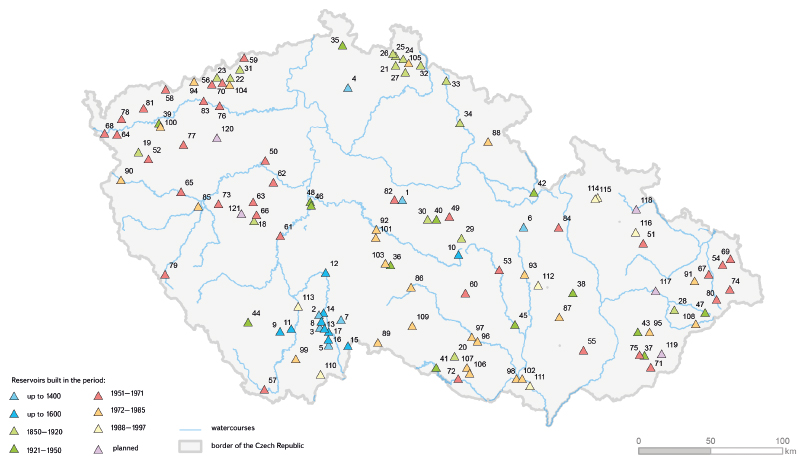
Fig. 1. Map of the Czech Republic, location of large hydraulic structures – differentiation according to the time of their origin
1 Velký rybník, 2 Bošilecký rybník, 3 Dvořiště, 4 Máchovo jezero, 5 Opatovický rybník, 6 Hvězda, 7 Velká Holná, 8 Záblatský, 9 Dehtář, 10 Velké Dářko, 11 Bezdrev, 12 Jordán, 13 Velký Tisý, 14 Horusický Pond, 15 Staňkovský rybník, 16 Svět, 17 Rožmberk, 18 Pilská, 19 Mariánské Lázně, 20 Jevišovice, 21 Harcov, 22 Jezeří, 23 Kamenička, 24 Bedřichov, 25 Fojtka, 26 Mlýnice, 27 Mšeno, 28 Bystřička, 29 Hamry, 30 Pařížov, 31 Janov, 32 Souš, 33 Labská, 34 Les Království, 35 Chřibská, 36 Sedlice, 37 Luhačovice, 38 Plumlov, 39 Březová, 40 Seč, 41 Vranov, 42 Pastviny, 43 Fryšták, 44 Husinec, 45 Brno (Kníničky), 46 Slapy, 47 Horní Bečva, 48 Štěchovice, 49 Křižanovice, 50 Klíčava, 51 Kružberk, 52 Podhora, 53 Vír, 54 Žermanice, 55 Koryčany, 56 Křímov, 57 Lipno, 58 Myslivny, 59 Fláje, 60 Mostiště, 61 Orlík, 62 Suchomasty, 63 Záskalská, 64 Jesenice, 65 Hracholusky, 66 Obecnice, 67 Olešná, 68 Skalka, 69 Těrlicko, 70 Jirkov, 71 Bojkovice, 72 Znojmo, 73 Klabava, 74 Morávka, 75 Ludkovice, 76 Nechranice, 77 Žlutice, 78 Horka, 79 Nýrsko, 80 Šance, 81 Tatrovice, 82 Vrchlice, 83 Kadaň, 84 Nemilka, 85 České Údolí, 86 Hubenov, 87 Opatovice, 88 Rozkoš, 89 Landštejn, 90 Lučina, 91 Větřkovice, 92 Želivka (Švihov), 93 Letovice, 94 Přísečnice, 95 Slušovice, 96 Mohelno, 97 Dalešice, 98 Nové Mlýny (upper), 99 Římov, 100 Stanovice, 101 Němčice, 102 Nové Mlýny (middle), 103 Trnávka, 104 Újezd, 105 Josefův Důl, 106 Těšetice, 107 Výrovice, 108 Karolinka, 109 Nová Říše, 110 Humenice, 111 Nové Mlýny (lower), 112 Boskovice, 113 Hněvkovice, 114 Dlouhé Stráně (lower reservoir), 115 Dlouhé Stráně (upper reservoir), 116 Slezská Harta, 117 Skalička, 118 Nové Heřminovy, 119 Vlachovice, 120 Kryry, 121 Amerika
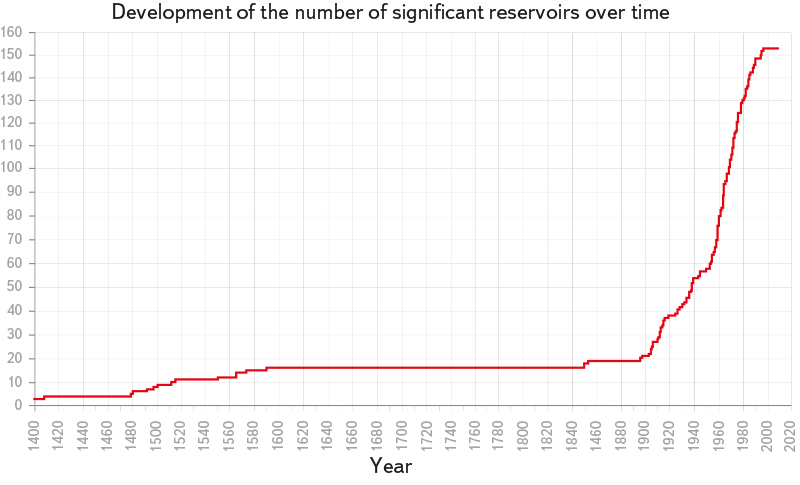
Fig. 2. Development of dam construction in the Czech lands (taken from: [21])
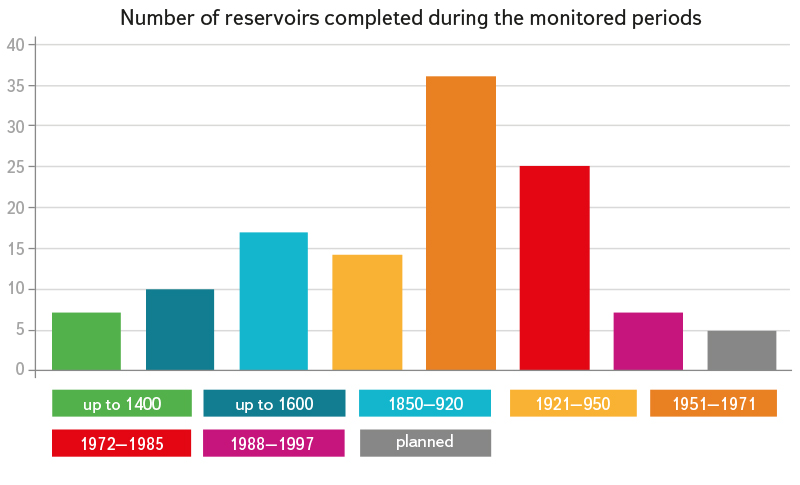
Fig. 3. Number of reservoirs built according to the monitored periods
Political changes in Czechoslovakia after 1948 initiated an era of planned but, suddenly, rather forced improvised construction of large water-management structures. The authoritarian nature of the regime allowed the entire implementation system, material, machinery, and labour to be put into operation relatively easily and without any hesitation, compared to the previous period of complex discussions, prevarication, and private ownership considerations. Authors like Zdeněk Pluhař, who was one of the builders of Vír reservoir, accommodated the need to change patterns of thinking in people’s minds similarly radically. Pluhař’s novel Modré údolí (Blue Valley) [10] does not mention the magical valley of Svratka nor the story of a specific building.
The schematic descriptions of characters and environment, as well as the development of events leading to the victory of builders over nature, are fully subordinated to this ideological assignment:
“Comrades, now we no longer work for somebody else’s profit, now we build for ourselves. The dam is ours, like everything in this state…” the inhabitants of a flooded village will not even remember the destruction of their houses because the dam – and trust in the ruling system – will free them from fear of the future. “After all, you will get rid of this eternal fear. You know very well what floods are in our valley, how awful it is when ice mass starts moving. Ask the dad, Julka, how many times people lost their shelter, their entire property, how many people died here during the floods. […] the first star already lit up in the purple sky a long time ago, and it was large and radiant.”
Little depended on the attitude of local residents, nature, landscape harmony, or even on the wider economic logic of such construction. Obstacles to new construction in the form of ownership relations, local social ties, public opinion and, in fact, anything could have been quite easily overcome by pointing out that a particular constructive activity is an indispensable part of “socialist care for citizens” and has no alternative. During the 20th century, over 100 villages disappeared due to the construction of water reservoirs [11, 12]. The legacy of one-sided conception and conviction of the clear contribution of the construction of large hydraulic structures left a lot of problems in the landscape and society, which remain unresolved to this day [13–15].
However, from the point of view of a water manager, this period seems somewhat different. In post-war Czechoslovakia, it was necessary to renew and complete the construction of basic infrastructure and industry.
The state water management plan of the Republic (in Czech known as SVP – Státní vodohospodářský plán) [16], was also elaborated on the basis of the knowledge and experience of pre-war Czechoslovakia during 1949–1953, and became the first systematic overview of the possibilities of using the state’s rich water resources. It was a directive-led plan for water management measures in all sectors of the national economy, as well as for spatial planning, enabling the use of water resources during individual floods on the basis of a detailed local survey. The plan initiated systematic monitoring and evaluation of data on natural conditions affecting water resources and water management, leading to its continuous update and completion. It elaborated the issue of drinking water supply, promoted complex and multi-purpose use of water resources, transition from local water supply system to group or regional water supply networks. It dealt with anti-flood treatment and drainage conditions of entire areas. It was a binding document which, among other things, enabled the emergence of a huge number of dams in a notably short time.
One of the current documents pertaining to the SVP regarding dam construction is the General Scheme on the Accumulation of Surface Water (in Czech known as Generel LAPV) [17], which, in terms of spatial planning, protects sites that could be used for the construction of dams in the event of continued climate changes in the future.
Period after 1990
As in earlier times, changes in ideas and their practical impacts do not happen overnight. Even before the revolution in November 1989, views on environmental issues were used for political and ideological battles; changes in circumstances still reverberated in subsequent years. Construction of some large hydraulic structures were suspended for some time in these crucial years and there were discussions about their purpose. In other cases, construction had already been suspended before 1989 for primarily economic reasons, although the authorities proclaimed acceding to discussions with environmental NGOs. Eventually, however, they were mostly completed and today they are beneficial to both energy and other water management purposes – for example, Dlouhé stráně pumped storage hydropower station, Silesian Harta hydraulic structure and, thirdly, Novomlýnské nádrže (Nové Mlýny reservoir). Political and ideological changes after 1990 also led to the rejection of economic instruments of socialism, such as the planned national economy and, at the same time, long-term planning in water management was also abandoned. Natural phenomena such as floods (e.g. 1997, 2002), torrential rains (continuously), or long-term drought (e.g. 2015–2017) showed that planning in water management was necessary so that the negative effects on the social environment, aimed at an immediate commercial or political profit, were at least partially counterbalanced. The requirements of European Union directives [18] and anticipated climate change have also brought water management planning back to the fore. Unlike the times of the SVP, these documents are now required to be discussed with the public and at the local government level [19].
From a historian’s point of view: the question is what practical long-term impact these plans will have on the future form of water management in the Czech Republic.
A cascade of three dam reservoirs in the Dyje river, under the Pavlov hills in southern Moravia, is a revealing example of this imposed technocratic solution. The government decision from May 1971 on the construction of Novomlýnské nádrže was the last step to be taken in any discussion about the issue of their construction, as evidenced by the following sentence in the chronicle of the flooded village of Mušov: “There won’t be any discussion about this. It’s a done deal.” Citizens were put in the position of mere “pawns” on an imaginary chessboard [21, 22]. The reservoirs were built to prevent annual flooding and to increase the intensity of agricultural production. Construction was justified by the socialist economy’s plans for extensive systems of irrigation of agricultural land, which were partially abandoned after 1989. From environmental activists’ point of view, it is just a lousily done water-management imitation which destroyed “the most valuable and most beautiful riparian forests in our country and perhaps in the whole of Central Europe” [23]. The church of St. Linhart (Fig. 4) rises above the water level of the middle reservoir as a memento.
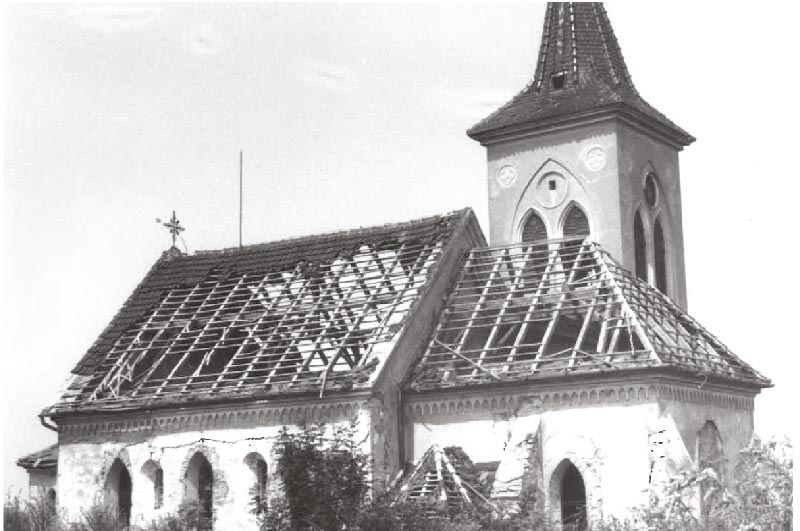
Fig. 4. Mušov church was to be demolished with the flooded village. It was saved at the last minute thanks to a group of students from the Department of art History of the Faculty of arts of Charles University who discovered frescoes on the oldest Romanesque wall of the church under layers of newer plaster. The condition of the church at the time of the first filling of the reservoir. (Photo: personal archive of I. Přibylová)
The construction of large hydraulic structures was always conditioned by the interplay of several influences: technical skills and natural conditions, intentions of the contractor and the investor, ideological background, and general awareness. All these influences are subject to change over time. The construction of every major hydraulic structure is time-consuming and, even during the construction itself, these conditions can change individually or in different combinations.
The construction of Bystřička masonry dam (Fig. 5) falls into the period before the First World War and it is an example of how the purpose and use of a hydraulic structure can change over time. The selection of the location and the size of the hydraulic structure were associated with the primary purpose of the water source for the planned controversial Danube-Odra canal. Although the idea of this canal has not come to pass so far, the hydraulic structure has, over the time of its existence, helped many times in coping with floods [24]. The reservoir is used continuously, mainly for recreational purposes; operatively it was used to rapidly increase the flow rates in the Bečva river and thus to dilute the concentrations of toxic substances at the time of a recent accident.
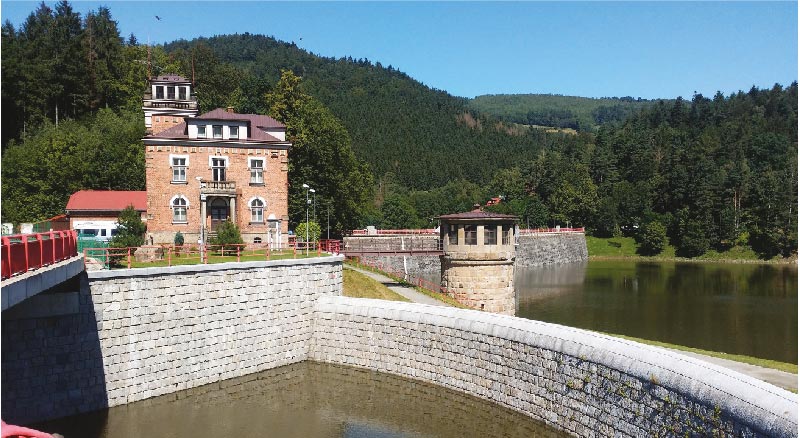
Fig. 5. Bystřička hydraulic structure completed in 1912, safety spillway
The planned Skalička hydraulic structure has also changed its main purpose and related suggested technical solution many times, without yet being fully built. The original intention was similar to that of Bystřička, i.e. in the period of socialism the reservoir was meant as a source of cooling water for a planned nuclear power plant, but after 1997, the flood control function prevailed (designed as a dry reservoir). Nowadays, in the period of longer-term drought, from a water management perspective, a solution in the form of a permanent water surface is coming to the fore.
After the Second World War, a newly introduced ideology coincided with majority awareness of the need for rapid post-war renewal of industry, energy development, and creation of a new society. Most of the dams built in the 1950s and 1960s were presented as large structures of socialism and their construction was usually not disputed. Later, in the period of normalisation of the 1970s and 1980s, hardly anybody believed the officially promoted ideology and, in the general awareness, there was an increasing shift toward environmental issues. The intention to build further dams was increasingly coming into conflict with the ideas of state conservation of nature. The integration of hydraulic structures into the landscape in different periods can be compared in Fig. 6 and 7.
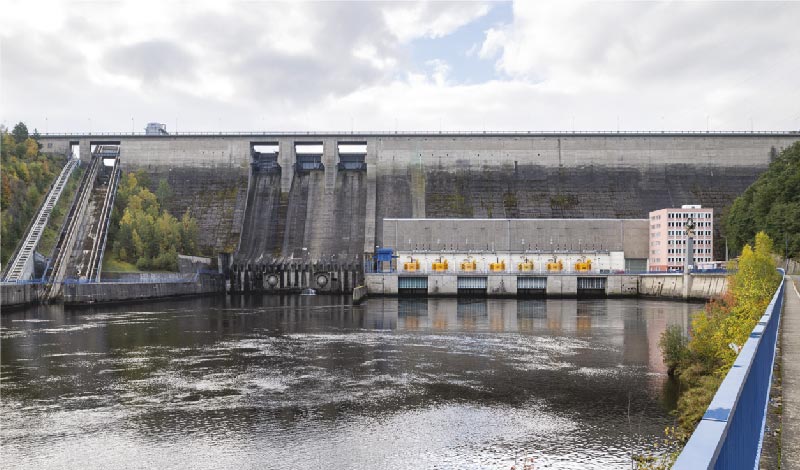
Fig. 6. Orlík hydraulic structure, concrete gravity dam completed in 1960 (Photo: V. Macha, 2021)
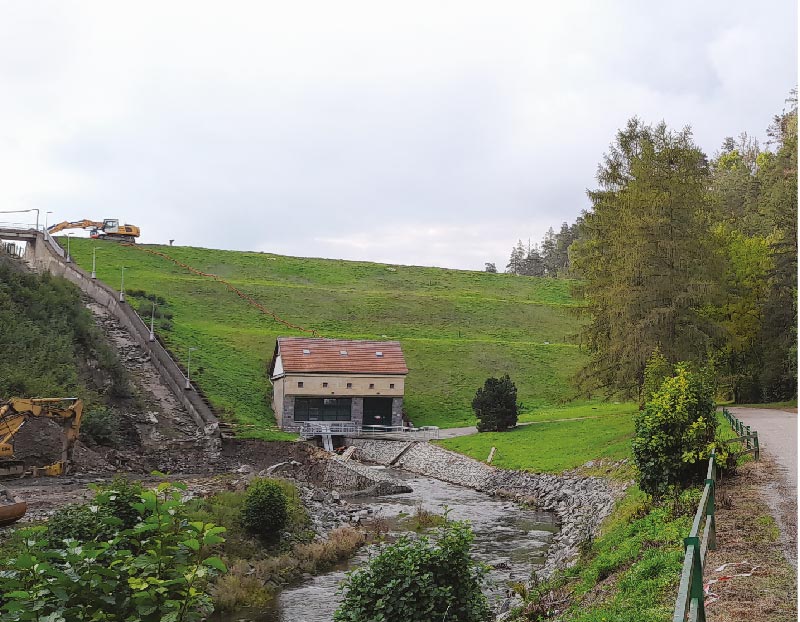
Fig. 7. Letovice hydraulic structure, an earth-filled dam completed in 1976. Its condition at the time of repairs of the safety spillway in 2022 (Photo: M. Forejtníková)
CONCLUSION
Despite all the differences in approaches of different fields towards the issue of dams and water management as a whole, it can be stated that some conclusions can be agreed on.
In the Middle Ages, water management was understood as jura regalia. In modern times, water is also considered a public possession and is a subject of public interest. The fragmentation of society at the beginning of the 21st century does not match the former techno-optimism, belief in progress or in the hierarchical management of society from above grounded in the expert opinions of the authorities. Nevertheless, solutions for the construction of large hydraulic structures which were tried and tested in the 20th century continue to be used where there is no other alternative for the provision of water needs for the future. The promotion of sustainable use of water resources with the preferences of subtler interventions brings harmonisation changes to the landscape, and an effort to return to natural water conditions is thus demonstrated. This trend is also reflected in new solutions by water management designers. Only time will tell to what extent a similar turn is also taking place in human minds – a turn towards restoring balance within ourselves.
Acknowledgements
This paper was created on the basis of the elaboration of the project “Historical water management objects, their value, function and significance for the present” situated within the NAKI II programme (project code DG18P02OVV019) of the Ministry of Culture.
